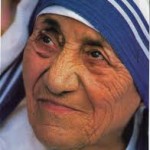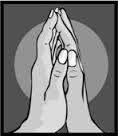TRUE NORTH…
…DON’T LISTEN TO MOM, SHE’S LOST AGAIN?
If I could have just one gift, it would be faith, for faith brings love and love brings peace–three gifts in one.
Henry F. Henrichs
Sunshine Magazine[1]
How could I ever point the way to True North? You know I would be a liar, Mom, the woman born without a compass.
When we travel as a family, the rule is, “Ask Mom which direction to turn, and then…go in exactly the opposite direction.” Generally, being in foreign territory, I am able to find an excuse for getting turned around. However, it takes a real ‘pro’ to get lost at home.
I even shocked myself one evening at Park Central Shopping Mall, only six blocks from the house. My husband and I came out of Dillards, got into the car, and I turned the key in the ignition. Only when I looked up to pull out of the parking space did I realize the awful truth, I was lost. I looked at Vic, embarrassed even to ask him. “Which way do I go?”
“What do you mean?” he asked.
“How do we get home?”
He spent five minutes trying to convince me to make a right turn up Central Avenue, a street I had traveled for over 10 years. I drove down one row after another in the parking lot, firm in my conviction that I had straightened my mind out, only to have him insist I must turn the car around. I can only imagine what I must have looked like to God from above, a wandering, confused ant on the sidewalk.
I finally stopped the car, stared around me, and mentally shook my head like a bobbing compass to get it pointed in the direction Vic was showing. There was nothing left to do. I gave up. In faith, knowing my husband is never lost, I pointed the car in the “wrong direction” and drove straight home.
I plan to reform restaurants with a new social movement: installing Lobby This A-Way signs. I need these signs every time I go to the bathroom in a restaurant. The way into the bathroom is easy. Just push the Women, Ladies, or Senoritas door. It’s only when I leave the bathroom, pushing out the Women’s door that I notice three other blank doors facing me. Not one helpful sign tells which door leads to the lobby. I have pushed hundreds of doors leading to the kitchen, the outside, and the supply closet. One day I want to see a door that says Lobby This A-Way so I will know how to get back to my dinner table.
As I try to figure out what makes me so bad at directions and makes my husband so good at directions, I have discovered one of my major problems. I don’t pay attention. I have tunnel vision. I am the horse with blinders. I know I need to go to the bathroom, and I see only one direct path to the Women sign. If only I would pay attention. I am part of a larger picture: the restaurant, the parking lot, the world. If I could learn to keep my attention turned to the world in which I roam, as I roam, I’m sure I would have an easier time at roaming and getting home at the end of the day.
Therefore, the search for True North belongs to others. It belongs to the people who have attended to life. They observe, ponder, think, and live, continuing always to observe, ponder, and think. Fortunately, for all of us, especially for me, some of them took the time as they finished their journey to write about the knowledge they gained.
I thrill at the touch of a book written by a thinker. I shudder with appreciation when I read a sentence of pure insight, distilled, a crystalline thought held on the page just for me. The author must have written that phrase just for Jane, feeling in his/her bones that I was lost again.
I am working to become an observer and a thinker, but it is impossible on my own. My blinders are too big, too fixed. When the world becomes too large to comprehend or to think about, I pull back, and “talk” with people inside books, doing my best to listen to their lives and experiences.
They are teaching me. True North, I have learned from them, is not a final destination we will ever see ourselves arrive at in this earthly life. It is a destination we set our sights on…a journey.
We must never turn off the compass. The minute we do, we will be like the skill saw that moves off the pencil line when sawing through a long board. At first, the saw seems to be close to the line. It’s only a small difference. But if the person holding the saw does not take control and force the saw back to its path, the board begins to tug at the saw, pulling it further and further, gradually, away from the pencil line and the intended path. A small sixteenth inch of an error can quickly become a gap of inches, only remedied with major surgery or a new board.
Life is like that. It can grab hold of me when I am paying the least attention. Suddenly, I will wake with the sun shining and with time on my hands to look around, and I will ask myself, “Where the HECK am I?” It is time to realign the compass.
The wise people who write books are my compass makers. They gently tug and point toward north. I read and hold counsel with distant authors: Jesus, Gandhi, and Mother Teresa. My days are filled with prayers of gratitude that they took the time to share their lives with me. With their words filling the sails of my life, I work daily to seek my way north, knowing true success will come far down the road, beyond the earthly horizon, where… when…no living human will be able to see if I made it or not.
[1] quoted in Sunday School Guide, April 6, 1997, volume 76, Issue 32, p. 16.
*******************************************************


